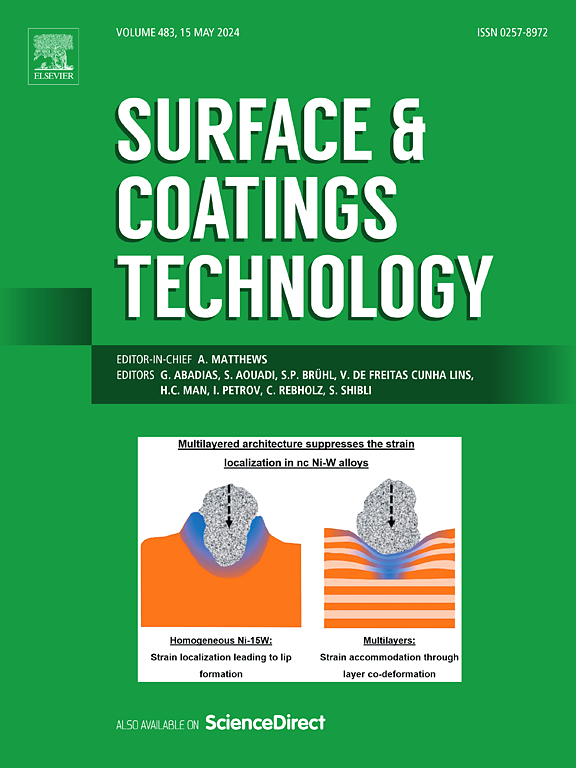Microstructure and thermal cycling behavior of Mo(Si, Al)2 dispersed GYYSZ multilayer composite coatings on molybdenum substrate under extreme environmental conditions
IF 5.3
2区 材料科学
Q1 MATERIALS SCIENCE, COATINGS & FILMS
引用次数: 0
Abstract
This study presents the design of a multilayer composite coating comprising a Mo(Si, Al)2 dispersed GYYSZ composite coating, a transition coating, and a Mo(Si, Al)2 antioxidant coating. The multilayer composite coating containing 10 vol% Mo(Si, Al)2 dispersed GYYSZ is designated as “GM”. In contrast, the multilayer coating containing pure GYYSZ serves as the control group and is designated as “GZ”. The coatings were prepared on the Mo substrate by the large plasma spraying. The coatings' performance was assessed through burner rig tests under high temperatures and significant temperature gradients, with each thermal cycle lasting 25 s. The coating surface temperature reached 2700 K in the tests. The test life of the GZ coating is only 1 cycle. Due to the connection of transverse cracks and vertical cracks, the Top coat of GZ exhibits clear delamination from the Transition coat, compromising the coating's protective function. In contrast, the test life of the GM coating is >5 cycles. The GM coating after tests maintains a strong bond between the two layers, showing no significant delamination. Subsequently, a long-term test of 360 s was conducted on the GM coating. After the test, cracks appeared on the coating surface, but no delamination was observed. The Top coat of GM develops three distinct layers post-tests: a porous layer, a sintered layer, and a nonsintered layer. The porous layer results from the volatilization of gaseous products and high-temperature flame erosion. The coating of the sintered layer is densified by sintering. The formation of glassy SiO2 and Al2O3 from Mo(Si, Al)2 oxidation, along with ZrSiO4 from the reaction of SiO2 with ZrO2, effectively fills and seals the pores within the sintered layer. This enhances the coating's longevity and inhibits oxygen diffusion. The dense sintered layer, coupled with the cooling effect of high-pressure water, effectively prevents oxidation of the nonsintered layer and the underlying coating. Following the long-term test, transverse cracks developed within the sintered layer of the GM coating due to the persistent oxidation of the Mo(Si, Al)2 phase, which was detrimental to the service life of the GM coating.
钼基Mo(Si, Al)2分散GYYSZ多层复合涂层在极端环境条件下的显微组织和热循环行为
本研究设计了一种多层复合涂层,包括Mo(Si, Al)2分散的GYYSZ复合涂层、过渡涂层和Mo(Si, Al)2抗氧化涂层。将含有10 vol% Mo(Si, Al)2分散GYYSZ的多层复合涂层称为“GM”。将含纯GYYSZ的多层涂层作为对照组,记为“GZ”。采用等离子喷涂技术在Mo基体上制备了涂层。在高温和显著温度梯度下,每个热循环持续25秒,通过燃烧器试验来评估涂层的性能。试验中涂层表面温度达到2700k。GZ涂层的试验寿命仅为1个周期。由于横向裂缝和垂直裂缝的连接,GZ的面漆与过渡层有明显的分层现象,影响了涂层的保护功能。相比之下,GM涂层的试验寿命为5次。经过测试的GM涂层在两层之间保持了牢固的结合,没有明显的分层现象。随后,对GM涂层进行了360 s的长期试验。试验结束后,涂层表面出现裂纹,但未见分层现象。GM的表面涂层在测试后形成三个不同的层:多孔层、烧结层和非烧结层。多孔层是气态产物挥发和高温火焰侵蚀的结果。通过烧结使烧结层的涂层致密化。Mo(Si, Al)2氧化生成的玻璃状SiO2和Al2O3,以及SiO2与ZrO2反应生成的ZrSiO4,有效地填充和密封了烧结层内的孔隙。这样可以延长涂层的使用寿命并抑制氧气扩散。致密的烧结层,加上高压水的冷却效果,有效地防止了未烧结层和底层涂层的氧化。经过长期试验,由于Mo(Si, Al)2相的持续氧化,导致GM涂层烧结层内部出现横向裂纹,影响了GM涂层的使用寿命。
本文章由计算机程序翻译,如有差异,请以英文原文为准。
求助全文
约1分钟内获得全文
求助全文
来源期刊

Surface & Coatings Technology
工程技术-材料科学:膜
CiteScore
10.00
自引率
11.10%
发文量
921
审稿时长
19 days
期刊介绍:
Surface and Coatings Technology is an international archival journal publishing scientific papers on significant developments in surface and interface engineering to modify and improve the surface properties of materials for protection in demanding contact conditions or aggressive environments, or for enhanced functional performance. Contributions range from original scientific articles concerned with fundamental and applied aspects of research or direct applications of metallic, inorganic, organic and composite coatings, to invited reviews of current technology in specific areas. Papers submitted to this journal are expected to be in line with the following aspects in processes, and properties/performance:
A. Processes: Physical and chemical vapour deposition techniques, thermal and plasma spraying, surface modification by directed energy techniques such as ion, electron and laser beams, thermo-chemical treatment, wet chemical and electrochemical processes such as plating, sol-gel coating, anodization, plasma electrolytic oxidation, etc., but excluding painting.
B. Properties/performance: friction performance, wear resistance (e.g., abrasion, erosion, fretting, etc), corrosion and oxidation resistance, thermal protection, diffusion resistance, hydrophilicity/hydrophobicity, and properties relevant to smart materials behaviour and enhanced multifunctional performance for environmental, energy and medical applications, but excluding device aspects.
 求助内容:
求助内容: 应助结果提醒方式:
应助结果提醒方式:


